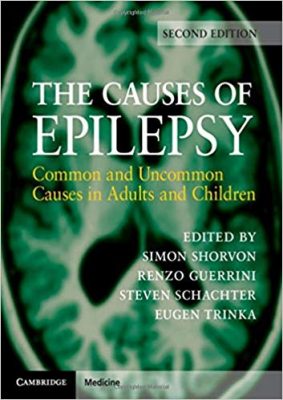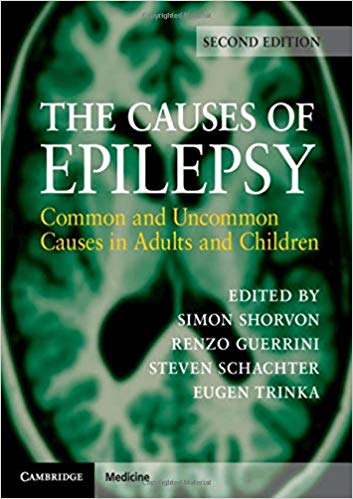 Editors: Simon Shorvon, Renzo Guerrini, Steven Schachter, and Eugen Trinka
Editors: Simon Shorvon, Renzo Guerrini, Steven Schachter, and Eugen Trinka
Publisher: Cambridge University Press – 989 pages
Book Review by: Nano Khilnani
The good news about epilepsy is that advances in medical technologies in the last few decades have enabled neurologists to determine the causes of many types of epilepsies. When a symptom of epilepsy such as a headache or seizure occurs, the first objective is to find its causes. In epilepsies, there are many different causes. These main points are mentioned and discussed by the four editors named above in the Preface to this second (2019) edition.
The advances in medical technologies helpful in diagnosis are of three basic kinds:
- Molecular chemistry
- Molecular genetics
- Neuroimaging
This book will be extremely valuable to all established and aspiring neurologists who are seeking answers to a plethora of questions relating to the conditions of their patients. In Section II, eight chapters contain specific information on how to do the clinical investigations relating to various possible causes of a number of epilepsy types.
In addition to the work done by the editors, the contributory efforts of nearly 200 other specialists make this book a very important reference resource.
One hundred ninety-eight specialists in various areas related to epilepsy, but mainly neurologists and neurosurgeons – from 23 countries around the world – Argentina, Australia, Austria, Belgium, Brazil, Canada, Croatia, Denmark, Finland, France, Ghana, Germany, India, Israel, Italy, Japan, Malaysia, Norway, Peru, Saudi Arabia, Spain, the United Kingdom, and the United States – authored the 128 chapters of this book under the guidance and supervision of the four editors.
These chapters are organized around seven Sections (and subsections marked with letters ‘a’ to ‘f’ under them) that we list below to provide you a broad overview of what is covered in this extensive book of nearly a thousand pages:
- Section I – Introduction
- Section II – Approaches to the Clinical Investigation and Diagnosis of Cause
- Section III – Idiopathic Epilepsies
- Section IV – Symptomatic Epilepsies of Genetic or Developmental Origin
- Single Gene Disorders and Inborn Errors of Metabolism
- Progressive Myoclonic Epilepsies
- Neurocutaneous Syndromes
- Epilepsies Associated with Chromosomal Abnormalities
- Epilepsies Associated with Developmental Anomalies of Cerebral Structure
- Section V – Symptomatic Epilepsies of Acquired Origins
- Epilepsies Associated with Cerebral Trauma
- Epilepsies Associated with Cerebral Tumors
- Epilepsies Associated with Cerebral Infection
- Epilepsies Associated with Cerebrovascular Disease
- Epilepsies Associated with Immunological Disorders
- Epilepsies Associated with Other Cerebral Disorders
- Section VI – Provoking Factors and Provoked Epilepsies: Reflex Seizures
- Section VII – Status Epilepticus
This extensive book on the latest findings with detailed textual and visual information is very useful in the analysis of various epilepsy cases. The most recent advances in diagnosis and treatment are a much-needed welcome addition to specialists involved in treating their patients.
Editors:
Simon Shorvon is Honorable Consultant Neurologist at the Hospital for Neurology and Neurosurgery in London, and Professor Emeritus in Clinical Neurology at University College London.
Renzo Guerrini is Professor of Child Neurology and Psychiatry and Director of the Department of Neuroscience at Children’s Hospital Anna Meyer at the University of Florence in Italy.
Steven Schachter is Professor of Neurology at Harvard Medical School and Chief Academic Officer at the Consortia for Improving Medicine with Innovation and Technology.
Eugen Trinka is Chair of the Department of Neurology and Medical Director of the Christian Doppler University Hospital and Center for Cognitive Neuroscience and Vice dean for Clinical Affairs of the Paracelsus Medical University in Salzburg, Austria.







